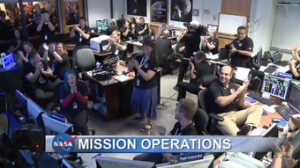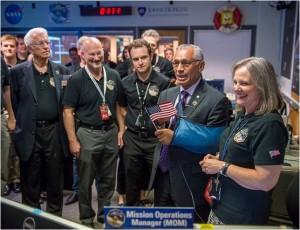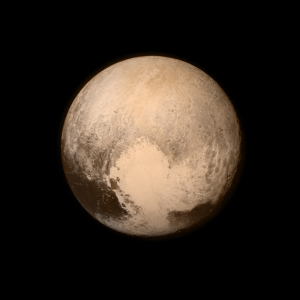
NASA’s New Horizons spacecraft phoned home, surviving its high-speed and close flyby of distant Pluto and its system of moons.
Credit: NASA
NASA’s New Horizons spacecraft phoned home to eagerly awaiting Earthlings – giving the “hi-sign” that it survived its high-speed and close flyby of distant Pluto and its system of moons.
At the Johns Hopkins University Applied Physics Lab in Laurel, Maryland, jubilant scientists and engineers breathed a sigh of relief that the data-collecting New Horizons remained in good condition after its Pluto encounter.

NASA Administrator Charles Bolden talks to the New Horizons team after they received confirmation from the spacecraft that it had successfully completed the flyby of Pluto, Tuesday, July 14, 2015 in the Mission Operations Center (MOC) of the Johns Hopkins University Applied Physics Laboratory (APL), Laurel, Maryland.
Credit: NASA/Bill Ingalls
Word from New Horizons Mission Operations Manager, Alice Bowman, pulsing her team of spacecraft operators, is that the probe is in fine shape, loaded with — and still collecting — science information and photos.

A monitor shows the status of NASA’s Deep Space Network as confirmation is received from the New Horizons spacecraft that it has completed the flyby of Pluto, Tuesday, July 14, 2015 at the Johns Hopkins University Applied Physics Laboratory (APL) in Laurel, Maryland.
Credit: NASA/Joel Kowsky
NASA will hold a press conference July 15 to release the latest findings and new imagery from New Horizons at 3 p.m. Eastern Time.

Pluto nearly fills the frame in this image from the Long Range Reconnaissance Imager (LORRI) aboard NASA’s New Horizons spacecraft, taken on July 13, 2015 when the spacecraft was 476,000 miles (768,000 kilometers) from the surface. This is the last and most detailed image sent to Earth before the spacecraft’s closest approach to Pluto on July 14. The color image has been combined with lower-resolution color information from the Ralph instrument that was acquired earlier on July 13. This view is dominated by the large, bright feature informally named the “heart,” which measures approximately 1,000 miles (1,600 kilometers) across. The heart borders darker equatorial terrains, and the mottled terrain to its east (right) are complex. However, even at this resolution, much of the heart’s interior appears remarkably featureless — possibly a sign of ongoing geologic processes.
Credit: NASA/APL/SwRI
|
Pluto just had its first visitor! Thanks @NASA – it’s a great day for discovery and American leadership. pic.twitter.com/FfztBSMbK0
|
||

